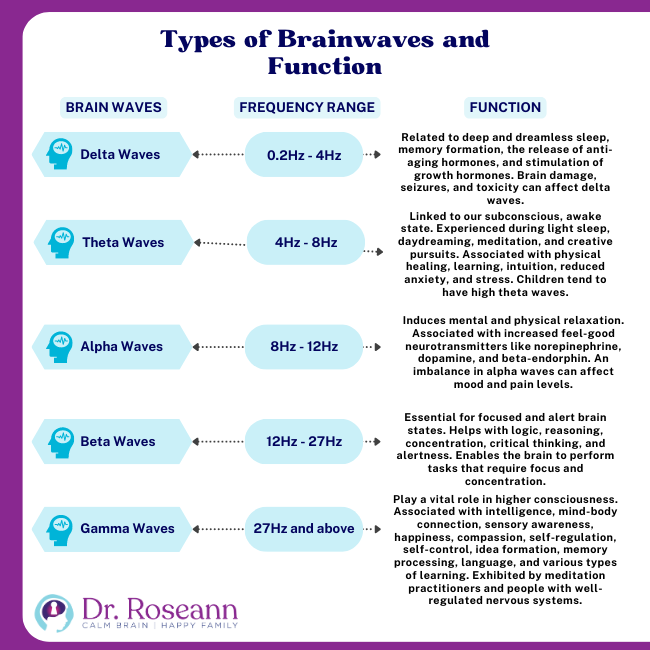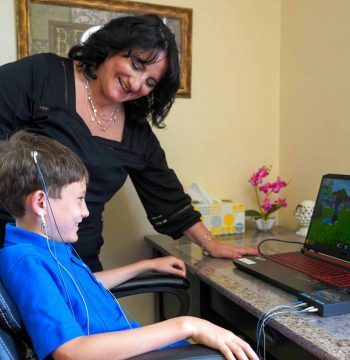Neurofeedback is a promising alternative for parents seeking a non-invasive, drug-free approach to addressing their child's behavioral or emotional challenges. So how does neurofeedback work and help?
Neurofeedback therapy can help children learn to regulate their brain activity, improve mood, reduce anxiety, and better focus and attention. It can be particularly helpful for children with ADHD, anxiety, depression, or learning difficulties, as well as those with developmental disorders such as autism spectrum disorder.
Neurofeedback was introduced in the 1960s and has been used ever since. Computer technology measures and provides feedback on brain activity during neurofeedback therapy. Their use steadily increased when personal computers became widely available in the late 1980s.
Numerous studies show the effectiveness of neurofeedback in treating various clinical conditions and psychiatric disorders impacting mental health, with more than 3,000 peer-reviewed studies showing this (Hammond et al., 2016).
The use of neurofeedback as a treatment method has gained wide acceptance in the past ten years. Yet, many doctors are still unaware of its numerous benefits of neurofeedback treatment. In the past, those seeking to improve their mental health only had two options: medication or psychotherapy. Neurofeedback, however, has emerged as a viable third option for mental health treatment.
How does Neurofeedback Therapy Work?
Neurofeedback therapy is a type of treatment that uses real-time feedback or displays of brain activity to help individuals learn how to regulate their brainwaves. It's a way to train the brain to function in a more balanced way.
During neurofeedback sessions, special sensors are placed on the scalp to measure the brain's electrical activity, and this information is used to provide visual or auditory feedback to the individual. Through practice and repetition, people can learn how to control their brainwaves, improving emotional regulation, reducing anxiety, and better cognitive function.
Repeated neurofeedback training sessions can enhance one's ability to regulate the brain to improve focus, attention, and impulse control. Neurofeedback is a non-invasive therapy that does not involve any medication or produce adverse effects.
It has proven highly effective in treating neurological conditions, diseases, and clinical ailments. For decades, it’s been used to treat attention deficit hyperactivity disorder, autism, learning disabilities, anxiety disorders, depression, concussion, stress, post-traumatic stress disorder, OCD, and sleep problems. The symptoms of these conditions involve dysregulation of the central nervous system, where neurofeedback can help.
Neurofeedback facilitates subconscious changes in an individual's brain waves through computer feedback, making them more regulated over time. During this transition, the sympathetic nervous system shifts from an activated, dominant state to a calm, focused one. As a result, one can concentrate, think, and act more effectively.
Several research studies consistently demonstrate that neurofeedback yields significant benefits (Marzbani et al., 2016). For example, over 90% of the people who use neurofeedback report substantial reductions in symptom severity and notable positive changes.
Neurofeedback aims to soothe the nervous system and bring it to a regulated parasympathetic state. It is done by balancing brainwaves and regulating neurotransmitters. Doing so removes the brain from the “fight or flight” response, enabling individuals to focus, think, and act. It can even improve musical and athletic performance.
A patient's success rate is often greater than expected, particularly after experiencing unsuccessful attempts with other treatments. In cases where success cannot be achieved, medical, nutritional, or environmental factors must be addressed.
What does Neurofeedback Therapy Do?

Neurofeedback therapy can alter brain functions. By reinforcing brainwave activity, neurofeedback stimulates new electrical activity in the brain and modifies neurotransmitter function. According to research by Ghaziri et al. (2013), neurofeedback affects brain structures by inducing changes in the brain's white and gray matter.
During a neurofeedback session, the therapist uses operant conditioning and reinforcement to promote learning, encouraging the brain to self-regulate while measuring brain wave activity to achieve a healthy rhythm. By identifying and reinforcing specific brainwave patterns, neurofeedback can help calm an overactive brain or stimulate an underactive one, improving focus, reducing anxiety, and better emotional regulation.
While neurofeedback training sessions are primarily used to alleviate clinical symptoms and enhance brain activity, some people use them to maximize brain performance or optimize its functioning.
Neurofeedback alters the patient's brainwaves to help the brain and body get into a regulated state. Brain waves are identified by their amplitudes and frequencies and indicate various brain states. These distinct patterns of electrical activity oscillate at different rates, measured in hertz (Hz), and their power is measured in microvolts (μV).
Each type of brainwave is important for different functions, and the patterning of brain waves, either too much or too little activity, over certain regions reflects the brain's health. For example, insufficient alert brain waves in the frontal lobes are associated with focus issues.
Here are the types of brain waves neurofeedback alters to improve one's well-being:
1. Delta Waves
The brain's delta waves, which oscillate between 0.2Hz and 4Hz, are related to deep and dreamless sleep. While in the delta state, the body releases anti-aging hormones like melatonin and DHEA. It also stimulates the pituitary gland to produce human growth hormone (HGH). Delta waves are crucial for memory formation and can be influenced by brain damage, seizures, and toxicity.
2. Theta Waves
Theta waves oscillate between 4Hz and 8Hz and are linked to our subconscious, awake state. Such a state is often experienced during light sleep, daydreaming, meditation, and creative pursuits. These waves are also associated with improved physical healing, learning, and intuition. It is also a state of reduced anxiety and stress. Children have high theta waves due to their open and imaginative minds.
3. Alpha Waves
Alpha waves between 8Hz and 12Hz induce mental and physical relaxation. This brainwave state is linked to increased feel-good neurotransmitters like norepinephrine, dopamine, and beta-endorphin, a peptide hormone. Mood and pain levels can be affected by alpha wave imbalance, whether too few or too many.
4. Beta Waves
Beta waves, oscillating between 12Hz and 27Hz, are essential for focused and alert brain states. This brainwave state helps with logic, reasoning, concentration, critical thinking, and alertness. It effectively enables the brain to perform tasks that require focus and concentration.
5. Gamma Waves
Gamma waves, with a frequency of 27Hz and above, play a vital role in higher consciousness. Intense gamma levels are associated with intelligence, mind-body connection, sensory awareness, happiness, compassion, self-regulation, self-control, idea formation, memory processing, language, and various types of learning. Meditation practitioners and people with well-regulated nervous systems often exhibit higher gamma wave levels.
What You Should Know About Neurofeedback
Neurofeedback can treat some of the most prevalent clinical concerns affecting children and adolescents today. EEG and neurofeedback is an effective, safe, and proven method of treating mental illness that should be considered standard practice. It is a safe alternative to ADHD medications and other psychiatric medications such as SSRIs to help your child or teen get focus, be less anxious and regulate behavior and mood.
Here are the common questions parents ask when considering using neurofeedback to address their kid's mental health disorders.
What Can I Expect From a Neurofeedback Session?
In our BrainBehaviorReset™ Program, the neurofeedback process begins with a quantitative EEG brain mapping or brain check, where EEG activity is recorded and analyzed statistically. After this, you will consult the clinician to review the brain map and develop a treatment plan. In our trademarked program, Dr. Roseann personally crafts a custom plan for you or your child based on her three decades of clinical experience working with thousands of children.
Once the protocol is established, your child can begin his neurofeedback sessions. Typically, individuals complete many sessions, between 40 and 50, performed two to three times weekly. During each session, sensors are placed on the scalp and ears, and brainwave reinforcement is provided as you watch a movie.
What is the goal of neurofeedback? While there are different types of neurofeedback, the goal of neurofeedback is to get the brain to self regulate.
Over time, the brain learns to stay healthy because of the reinforcement it receives. That means focusing, remaining calm, and processing are typically improved.
What is the Efficacy of Neurofeedback?
Neurofeedback has been valuable for many years in addressing symptoms related to neurological disorders and other clinical conditions such as ADHD, OCD, anxiety, depression and mood disorder, autism, concussion, learning disabilities and dyslexia, autoimmune conditions, etc.
Families seeking a non-invasive and medication-free way to manage the symptoms of mental health conditions in kids can benefit from this therapy. It is an evidence-based treatment that aids in regulating brain activity in both children and adults.
Why is Neurofeedback Recommended for Children and Teens?
Neurofeedback therapy is a natural and pleasant option for parents looking for an alternative to psychiatric medications or stimulants for their children and teens. It has been extensively researched and scientifically proven to effectively treat a wide range of clinical conditions that many young people face today. The best part? Neurofeedback therapy has no notable adverse side effects, making it a safe and gentle way to support your child's mental health.
If your child is struggling with ADHD, anxiety, depression, or learning difficulties, neurofeedback therapy may be just what they need. Unlike medications, which can have unwanted side effects and often only treat symptoms, neurofeedback therapy addresses the root cause of these issues by teaching your child's brain how to regulate itself. And because it is a natural treatment option, you can feel good about supporting your child's mental health without exposing them to harmful chemicals or substances.
Is Neurofeedback the Same as Biofeedback?
It's easy to confuse biofeedback and neurofeedback, which are different treatments. However, it's also important to note that neurofeedback differs from biofeedback and involves conscious control of autonomic functions. In contrast, neurofeedback operates at the subconscious level to adjust brainwave patterns.
Biofeedback involves using devices to control heart rate, temperature, muscle tension, and skin conductance. Therefore, it is a good adjunct therapy to neurofeedback for reducing stress and chronic pain.
How is Neurofeedback Different From TMS and TENS?
TMS stands for Transcranial Magnetic Stimulation, which uses magnets to alter brain activity. It mainly treats depression in adults and involves wearing a special helmet where magnetic activity travels through the scalp.
On the other hand, TENS means Transcutaneous Electrical Nerve Stimulator. This device uses low-voltage electrical impulses to stimulate the nerves. But unlike both methods, neurofeedback doesn't get anything through the wires to change brain functioning. Instead, it uses a process of reinforcement and measurement.
Neurofeedback Therapy for Kids and Teens
So, if you're a parent looking for a safe, effective, and natural way to support your child's mental health, neurofeedback therapy may be just what you need. With its proven track record of success and lack of adverse side effects, it's a treatment option that you and your child can feel good about.
If you're a parent who wants the best for your child's mental and emotional well-being, you need to learn more about how our BrainBehaviorReset™ Program can help. We offer top-quality neurofeedback therapy for kids and teens at our Ridgefield clinic and virtually at home for families across the US and worldwide.
Neurofeedback therapy is a well-researched yet innovative and effective way to enhance your child's mental health. Neurofeedback treatment helps children learn to manage their emotions, reduce anxiety, and improve focus and attention by using advanced technology to monitor and regulate brainwave activity.
Whether searching for biofeedback near me or neurofeedback near me, look for a neurofeedback therapist that is specialized in your child's clinical issue. But working with a qualified mental health practitioner is essential to ensure the therapy is tailored to your child's unique needs and delivered safely and effectively.
That's where our BrainBehaviorReset™ Program comes in. Our personalized approach combines neurofeedback therapy with other evidence-based modalities like PEMF, nutrition and supplementation, and cognitive behavior therapy, among others, to create a comprehensive care plan that meets the needs of each child.
With the guidance and support of our team of experienced mental health professionals, you can feel confident that your child is receiving the best possible care and is on the path to improved mental and emotional well-being.
We work with families to support common clinical issues facing children, teens, and their families, including ADHD, anxiety, autism, executive functioning, learning disability and dyslexia, PANS/PANDAS, Lyme Disease, OCD, and mood and behavior dysregulation. You can learn more about our client successes by reading our case studies.
We support parents in finding natural ways to support the brain, improve attention, and calm behavior. When the brain is regulated and calm, then a child can learn. It is time to add and focus on new learning through psychotherapy and parent coaching.
So don't wait any longer to support your child's behavior and mental health. Contact us today to learn more about our BrainBehaviorReset™ Program and how neurofeedback therapy can help your child reach their full potential. With its proven track record of success and lack of adverse side effects, it's a treatment option that you and your child can feel good about.
Citations
Ghaziri, J., Tucholka, A., Larue, V., Blanchette-Sylvestre, M., Reyburn, G., Gilbert, G., Lévesque, J., & Beauregard, M. (2013). Neurofeedback Training Induces Changes in White and Gray Matter. Clinical EEG and Neuroscience, 44(4), 265–272. https://doi.org/10.1177/1550059413476031
Hammond, D. C., Novian, D. A., & Duffy, F. H. (2016, November 11). Comprehensive Bibliography of Neurofeedback Research. ISNR. https://isnr.org/isnr-comprehensive-bibliography
Marzbani, H., Marateb, H., & Mansourian, M. (2016). Methodological Note: Neurofeedback: A Comprehensive Review on System Design, Methodology and Clinical Applications. Basic and Clinical Neuroscience Journal, 7(2). https://doi.org/10.15412/j.bcn.03070208
Dr. Roseann is a mental health expert in Neurofeedback who frequently is in the media:
- It's Gonna Be OK! With Dr. Roseann Podcast: Neurofeedback Series
-
Mel Robbins Show : Neurofeedback
-
Clearly Clinical Podcast: Neurofeedback
-
Creative Clinician's Corner: Neurofeedback
-
Everyday Wellness Podcast: Neurofeedback and Teen Mental Health
-
How Humans Heal Podcast: Neurofeedback
- Aspire.care: PANS/PANDAS and Neurofeedback
- Soaring Child Podcast: Neurofeedbackrea
Always remember… “Calm Brain, Happy Family™”
Are you looking for SOLUTIONS for your struggling child or teen?
Dr. Roseann and her team are all about solutions, so you are in the right place!
There are 3 ways to work with Dr. Roseann:
Dr. Roseann is a Children’s Mental Health Expert and Licensed Therapist who has been featured in/on hundreds of media outlets including The Mel Robbins Show, CBS, NBC, PIX11 NYC, Today, FORBES, CNN, The New York Times, The Washington Post, Business Insider, Women’s Day, Healthline, CNET, Parade Magazine and PARENTS. FORBES called her, “A thought leader in children’s mental health.”

She coined the terms, “Re-entry panic syndrome” and “eco-anxiety” and is a frequent contributor to media on mental health.
Dr. Roseann Capanna-Hodge has three decades of experience in working with children, teens and their families with attention-deficit hyperactivity disorder (ADHD), autism, concussion, dyslexia and learning disability, anxiety, Obsessive Compulsive Disorder (OCD), depression and mood disorder, Lyme Disease, and PANS/PANDAS using science-backed natural mental health solutions such as supplements, magnesium, nutrition, QEEG Brain maps, neurofeedback, PEMF, psychotherapy and other non-medication approaches.
She is the author of three bestselling books, It’s Gonna Be OK!: Proven Ways to Improve Your Child's Mental Health, The Teletherapy Toolkit, and Brain Under Attack. Dr. Roseann is known for offering a message of hope through science-endorsed methods that promote a calm brain.
Her trademarked BrainBehaviorResetⓇ Program and It’s Gonna be OK!Ⓡ Podcast has been a cornerstone for thousands of parents facing mental health, behavioral or neurodevelopmental challenges.
She is the founder and director of The Global Institute of Children’s Mental Health, Neurotastic™Brain Formulas and Dr. Roseann Capanna-Hodge, LLC. Dr. Roseann is a Board Certified Neurofeedback (BCN) Practitioner, a Board Member of the Northeast Region Biofeedback Society (NRBS), Certified Integrative Mental Health Professional (CIMHP) and an Amen Clinic Certified Brain Health Coach. She is also a member of The International Lyme Disease and Associated Disease Society (ILADS), The American Psychological Association (APA), Anxiety and Depression Association of America (ADAA) National Association of School Psychologists (NASP), International OCD Foundation (IOCDF).
© Roseann-Capanna-Hodge, LLC 2024
Disclaimer: This article is not intended to give health advice and it is recommended to consult with a physician before beginning any new wellness regime. *The effectiveness of diagnosis and treatment vary by patient and condition. Dr. Roseann Capanna-Hodge, LLC does not guarantee certain results.














